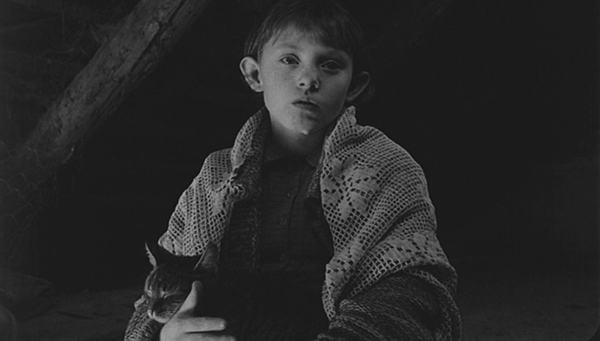





Dir.: Bela Tarr; Cast: Mihaly Vig, Istvan Horvath, Erika Bök, Peter Berling, Miklos B. Szekely, Laszlo Fe Lugossy, Eva Almassi Albert, Alfred Jaray, Erzsebet Gaal, Janos Derzsi, Iren Szajki; Hungary/Germany/Switzerland 1991/93, 450′.
Based on the novel 1985 by co-writer Laszlo Krasnahorkai, Bela Tarr’s collaborator in his final five feature films, Sátántangó is a human tragedy that deals with time, memory and melancholy, delving into the final years of Communism in a Hungarian village, where everyone plays a part in their collective fate.
Filmed in long tracking shots, the opening sequence – an eight minute take of cows ruminating in the grounds of a decaying estate – is symbolic for what is to follow. Told in two parts with six episodes each, Santantango uses tango steps for the retrogressive dance sequences as the story unfolds. The work of Samuel Beckett and Thomas Bernhard clearly springs to mind, but Tarr/Krasmahorkai add an extra dimension of absolute stasis that contrasts with the characters’ overriding desire to escape their fate from the outset.
The story begins in 1990s Hungary where life has come to a standstill for a group of farmers waiting for their collective farm to be shut down. Their plan is to move to a new location. But socially things are looking bleak: Futaki (Szekely) is having an affair with Mrs. Schmidt (Albert); Mr. Schmidt (Lugossy) is trying to steal the money the villagers have put aside for their escape plan. Futaki demands to be part of the scheme. All this goes on under the beady eye of a drunk Doctor (Berling) who chronicles the unfolding narrative.
However, the master plan is abandoned when the villagers discover that Irimias (Vig) and his manipulative co-conspirator Petrina (Horvath) have returned. The two have struck a deal with the police captain to spy on the villagers. The doctor has run out of brandy, and after replenishing his supplies, he meets the young Estike (Bök), who asks him desperately for help. But the doctor passes out in the wood. The morning before, Estika had been tricked into planting a ‘money tree’ by her brother in the nearby wasteland. Estike tortures and poisons her cat to show she has some form of control over her life, but she soon loses the plot, like many others who are seen dancing in the pub.
But Estike has a shred of humanity, and is overcome by grief after her cruelty to the cat. She asks the doctor to save her pet, but this episode ends in tragedy. Meanwhile Irimias then turns his efforts to convincing the villagers to hand over the escape money. But he also has another dastardly plan up his sleeve. And the story ends with the doctor returning to the abandoned farm, unaware he is alone. On hearing the church bells ringing and a madman shouting: “the Turks are coming”, the doctor nails his windows shut and starts the narration from its beginning.
Gabor Medvigy’s intimate camera encircles the characters with long panning shots and cold-blooded close-ups, leaving nothing to the imagination. Tarr shows us that there are three cinematic worlds to escape into: the one of beauty, the ugly one and the empty one. Beauty belongs to the works of Tarkovsky; Ozu’s films meditate the void, and the early works of Antonioni portray ugliness.
Dedicating a whole day to watch Satantango is to immerse yourself in a world of visual wonder. It’s not that there is so much to tell, but because there is so much to understand. Neo-Realism revolutionised the world of cinema by allowing the audience to participate, and take part in the composition. Neo-Realism is only effective if the audience can watch the film from the inside. If today’s films want to be meaningful they need to focus on the strength of the script, rather than degenerating into attention-grabbing digital trickery.
Satantango offers a chance to immerse ourselves completely in a point in time, and be a part of the story. Watch and submerge yourself in the reality of this remarkable story-telling – and join the world of sense and sensibility. AS
NOW AVAILABLE ON BFI Player | Also on Bluray